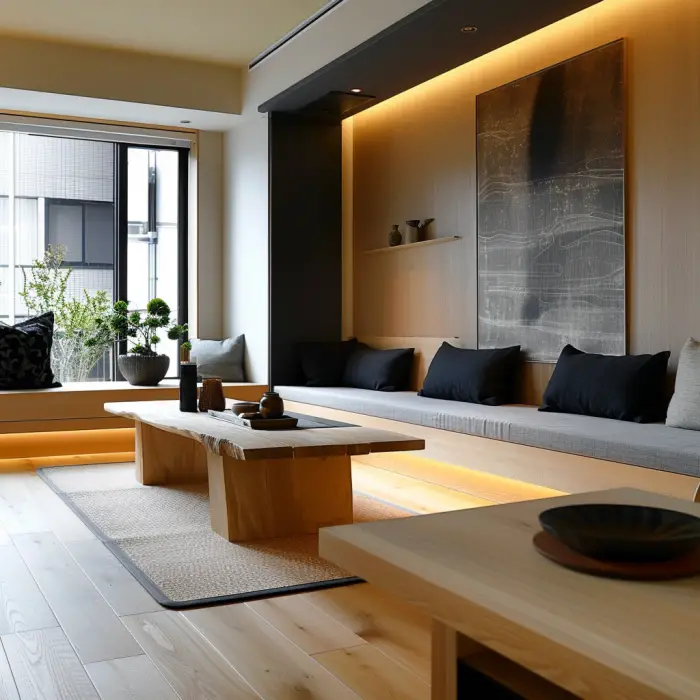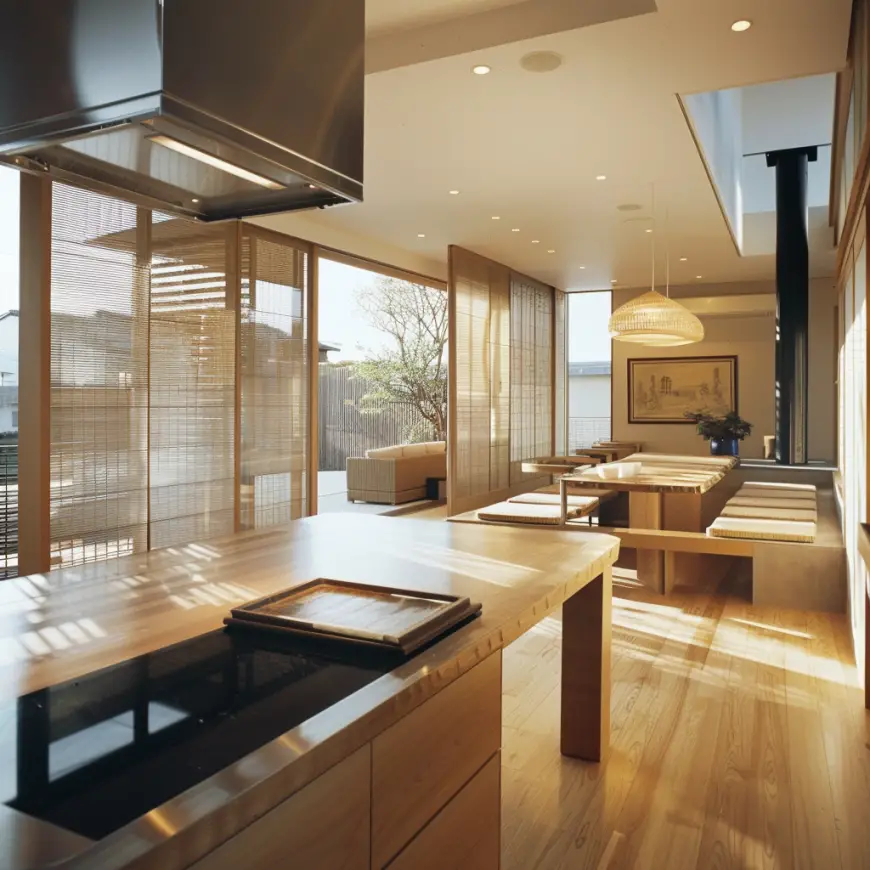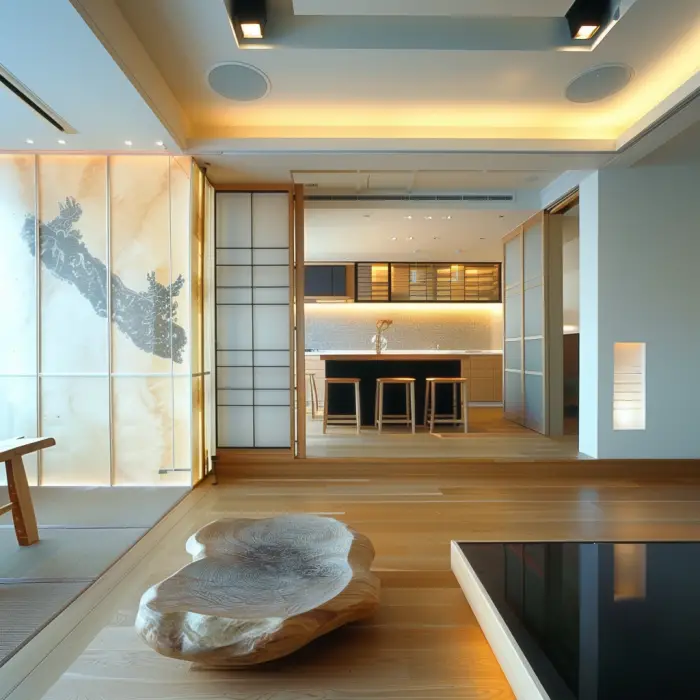Japanese interior design is renowned globally for its minimalist beauty, impeccable use of space, and the tranquil ambiance it cultivates. This style, deeply rooted in the country’s rich history and cultural philosophies, offers a unique aesthetic that blends traditional elements with modern sensibilities. For those looking to introduce a sense of calm and order into their homes, adopting Japanese design principles can be transformative.

In this detailed exploration, we will delve into the evolution of Japanese interior design, understand the philosophical backbone provided by wabi-sabi, examine the key characteristics of the style, and provide practical advice on integrating these elements into various living spaces. Additionally, we will discuss the advantages and challenges of this design philosophy, showcase real-life transformations, and address common questions. Whether you’re a professional designer or a homeowner seeking inspiration, this guide aims to equip you with the knowledge and tools to bring a touch of Japanese elegance into your living environment.
History of Japanese Interior Design
The origins of Japanese interior design are intricately linked to the country’s architectural traditions, which have been shaped by geographical, climatic, and social factors. Traditional Japanese architecture, known for its wooden structures and elevated floors, has played a pivotal role in the development of interior aesthetics. The design was primarily influenced by the need for flexibility in use of space and the integration of the natural environment, principles that are still prevalent in modern designs.
During the Heian period (794-1185), the introduction of residential styles such as shinden-zukuri set the stage for later developments. These homes were characterized by open floor plans that allowed for fluid movement and multi-functional spaces. As time progressed, the more restrained machiya (townhouses) and the minimalist aesthetics of the tea houses in the Muromachi (1336-1573) and Momoyama (1573-1603) periods further defined the focus on simplicity and natural materials—traits celebrated in contemporary Japanese interiors.
The post-World War II era brought significant Western influence, but modern Japanese design continues to echo the minimalist and functional ethos of its traditional roots. Today, interior designers worldwide draw inspiration from these historical elements, using them to craft spaces that are both serene and practical.
Wabi-Sabi: Embracing Imperfection
Wabi-sabi represents a central philosophy in Japanese aesthetics, emphasizing beauty found in imperfection and transience. Rooted in Zen Buddhism, wabi-sabi invites us to appreciate the rustic simplicity, quietude, and subtle integrity of objects and spaces. In interior design, this translates to an appreciation for handmade elements, asymmetrical forms, and the use of materials that age gracefully.
Implementing wabi-sabi in modern interiors involves choosing finishes and furniture that celebrate natural imperfections, such as unpolished wood, irregular stone surfaces, or hand-thrown pottery. The color palette remains subdued, with earthy tones that blend harmoniously with the natural world outside. This approach not only cultivates a visually calming space but also fosters a deeper connection to the objects and surroundings on a daily basis.
Characteristics of Japanese Interior Design
Japanese interior design is marked by a few distinctive characteristics that set it apart:
Minimalism: Central to Japanese aesthetics, minimalism means keeping spaces uncluttered and simplistic, focusing on what is necessary. This not only enhances the beauty of each piece within the room but also promotes a sense of tranquility and order.

Natural Materials: Wood, bamboo, rice paper, and stone play significant roles in creating a connection to nature. These materials are not only sustainable but also carry intrinsic qualities of warmth and authenticity.

Neutral Colors: The color scheme in a Japanese-style home tends to be calm and muted, with a lot of whites, beiges, and earth tones. These colors reflect the natural landscape and help create a serene environment.

Sliding Doors: Instead of traditional Western doors, many Japanese homes utilize sliding doors (fusuma), which save space and can be used to reshape the living areas as needed.

Tatami Mats: These are straw mats that are used as flooring in traditional Japanese rooms. They are both functional and aesthetic, lending a distinct texture and scent that is uniquely Japanese.

How to Implement Japanese Interior Design in Different Rooms
Implementing Japanese interior design can transform conventional rooms into serene, minimalist environments that promote calm and simplicity. Here’s how you can apply these principles in different areas of your home:
Living Room: Opt for low-profile, straight-lined furniture, such as a kotatsu (a low wooden table with a heat source underneath and a blanket over the top) for a unique functional piece. Use neutral colors like soft greys, wood tones, and creams. Consider a natural fiber area rug or a bamboo floor mat to define the seating area. For decorations, choose one or two pieces of simple, nature-inspired art, avoiding clutter.

Bedroom: The bedroom should be a bastion of tranquility. Use a low wooden bed frame or even a futon mattress directly on tatami mats for a traditional feel. Keep bedding natural and subdued in color. Opt for built-in wardrobes or closets with sliding doors to save space and reduce visual clutter. Soft, indirect lighting can enhance the serene atmosphere, and a small, elegant ikebana (Japanese flower arrangement) can add a touch of nature.

Kitchen: Japanese kitchens are typically streamlined and functional. Use open shelving to store and display beautiful dishware, which acts as decor. Materials like bamboo or reclaimed wood can be used for the shelves. Incorporate a small herb garden in the kitchen window to bring in greenery and practical use. Keep the countertops mostly clear, storing appliances in cupboards to maintain a minimalist aesthetic.

Bathroom: To create a Zen-like bathroom, install a deep soaking tub (ofuro) if space permits. Use natural stone or wooden elements for the sink and countertop areas. Consider a rainfall shower with a pebble-tiled floor to imitate the feeling of bathing in a natural spring. Candles and incense can add an aroma-therapeutic aspect to the relaxation space.

Pros and Cons of Japanese Interior Design
Pros:
- Aesthetic Appeal: Japanese design is timeless, emphasizing clean lines, minimalism, and balance that appeal to a wide audience.
- Promotes Zen-like Feel: The arrangement and style promote tranquility and peace, conducive to mental well-being.
- Efficient Use of Space: Good for small spaces due to its emphasis on functionality and minimalism.
Cons:
- Lack of Color and Accessory Diversity: For some, the color schemes might be too bland and the minimalist approach too restrictive.
- Maintenance: Keeping spaces minimal and free of clutter requires constant tidying and discipline.
Conclusion
Embracing Japanese interior design can transform an ordinary space into a peaceful sanctuary. This style’s emphasis on minimalism, natural materials, and fluidity between spaces not only enhances the aesthetic value of a home but also promotes a lifestyle that appreciates simplicity and harmony. As we continue to seek tranquility in our hectic lives, the principles of Japanese design offer a timeless solution.
Frequently Asked Questions (FAQ)
- How can I start incorporating Japanese design into my home? Start with one room and introduce elements like tatami mats, Japanese art, or sliding doors.
- Is Japanese interior design expensive? It can be, depending on materials and furnishings. However, the minimalist approach can also lead to fewer purchases and lower costs.
- How do I maintain the minimalist look? Regular decluttering and thoughtful purchasing are crucial to maintaining a minimalist aesthetic.

